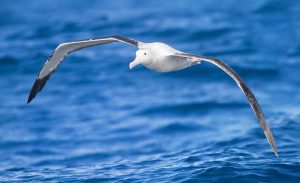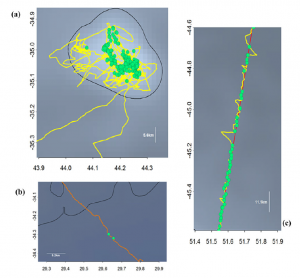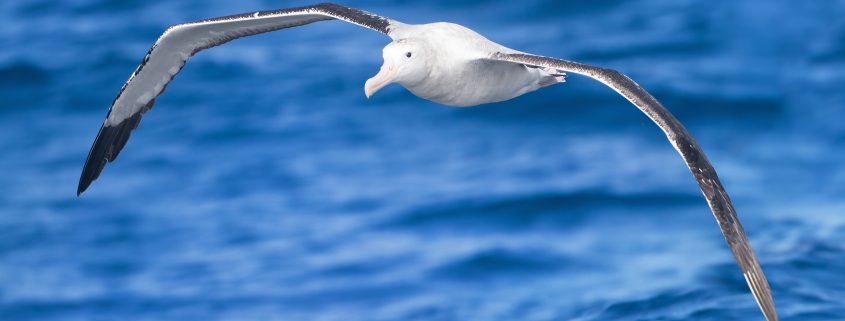A Bird’s Eye View of Illegal Fisheries
By Mitchell Rider, SRC Intern and MS student
Seabirds have been attracted to vessels for centuries, but more recently, they have been observed to aggregate in large quantities near fishing vessels to feed on fish scraps or bait (Croxall et al. 2012; Phillips et al. 2016). Their interactions with fishing vessels have been observed and quantified using Global Positioning System (GPS) combined with vessel monitoring-system (VMS) data, however, this type of analysis can only be carried out with declared vessels whose position can be tracked within exclusive economic zones (EEZs). Therefore, there is little information available on the interaction of seabirds and fishing vessels outside the EEZs. In their study “Use of radar detectors to track attendance of albatrosses at fishing vessels”, Weimerskirch et al. (2017) set out to estimate the efficiency of fitting newly developed GPS loggers to wandering albatrosses (Diomedea exulans) (Fig. 1), foraging from the Crozet Islands, to detect fishing vessels at sea in addition to observing the extent to which the fishing vessel operations were overlapping with D. exulans foraging range.

Photo of Diomedea exulans [https://commons.wikimedia.org/wiki /Diomedea_exulans#/media/File:Diomedea_ exulans_in_flight_-_SE_Tasmania.jpg]
Birds from Possession Island, Crozet Islands, were hand caught and an XGPS radar logger was taped to their back feathers. These radar loggers could detect interactions between the birds and fishing vessels by measuring radio emissions at a certain frequency that is used in marine radars. From this interaction data, the authors could determine three different types of behaviors of birds associated with the radar detections: fly pasts, follows, and vessel attendance (Fig. 2). Fly pasts occurred if there were a few successive radar detections but no significant change in the route of the bird, however, successive radar detections associated with a linear direction was noted as a follow. Vessel attendance was noted as successive radar detections in a restricted area where the bird alternated between flying and sitting on the water. This data was combined with VMS data of French long-line fishing vessels to note the distance between the GPS tagged birds and the fishing vessels.

Movement pattern of wandering albatrosses (yellow and orange lines) equipped with biologging devices that detect radar emissions and record the position of boats (green dots): (a) attending behavior, (b) fly-past behavior, and (c) follow behavior where the red line is the track of the vessel (Wiemerskirch et al. 2017).
A total of 43 foraging trips were recorded from with the XGPS radar loggers and Wimerskirch et al. (2017) discovered that 79.5% of the loggers recorded interactions with vessel radars. Among the three types of interactions with ships, D. exulans was noted to spend the highest percentage of radar detections in attendance of the ships (64.7%), followed by fly pasts (23.9%), and follows (8.8%). In general, the birds spent a large amount of time behind the vessels, which suggested more of an attraction to the vessel, instead of a spatial overlap. Even though there is this significant interaction between D. exulans as fishing vessels, the answer as to why these birds are attracted to fishing vessels is not clear. However, these findings suggest that this method of radar detection on seabirds could become an effective way to manage marine ecosystems. More specifically, radar detection on seabirds could be used to detect the location of illegal fishing vessels outside of EEZs.
Works Cited
Croxall, J. P., Butchart, S. H., Lascelles, B., Stattersfield, A. J., Sullivan, B., Symes, A., & Taylor P. (2012). Seabird conservation status, threats and priority actions: a global assessment. Bird Conservation International 22:1–34.
Phillips, R., Gales, R., Baker, G., Double, M., Favero, M., Quintana, F., Tasker, M., Weimerskirch, H., Uhart, M., & Wolfaardt, A. (2016). The conservation status and priorities for albatrosses and large petrels. Biological Conservation 201:169–183.
Weimerskirch, H., Filippi, D. P., Collet, J., Waugh, S. M., & Patrick, S. C. (2017). Use of radar detectors to track attendance of albatrosses at fishing vessels. Conservation Biology.




Leave a Reply
Want to join the discussion?Feel free to contribute!